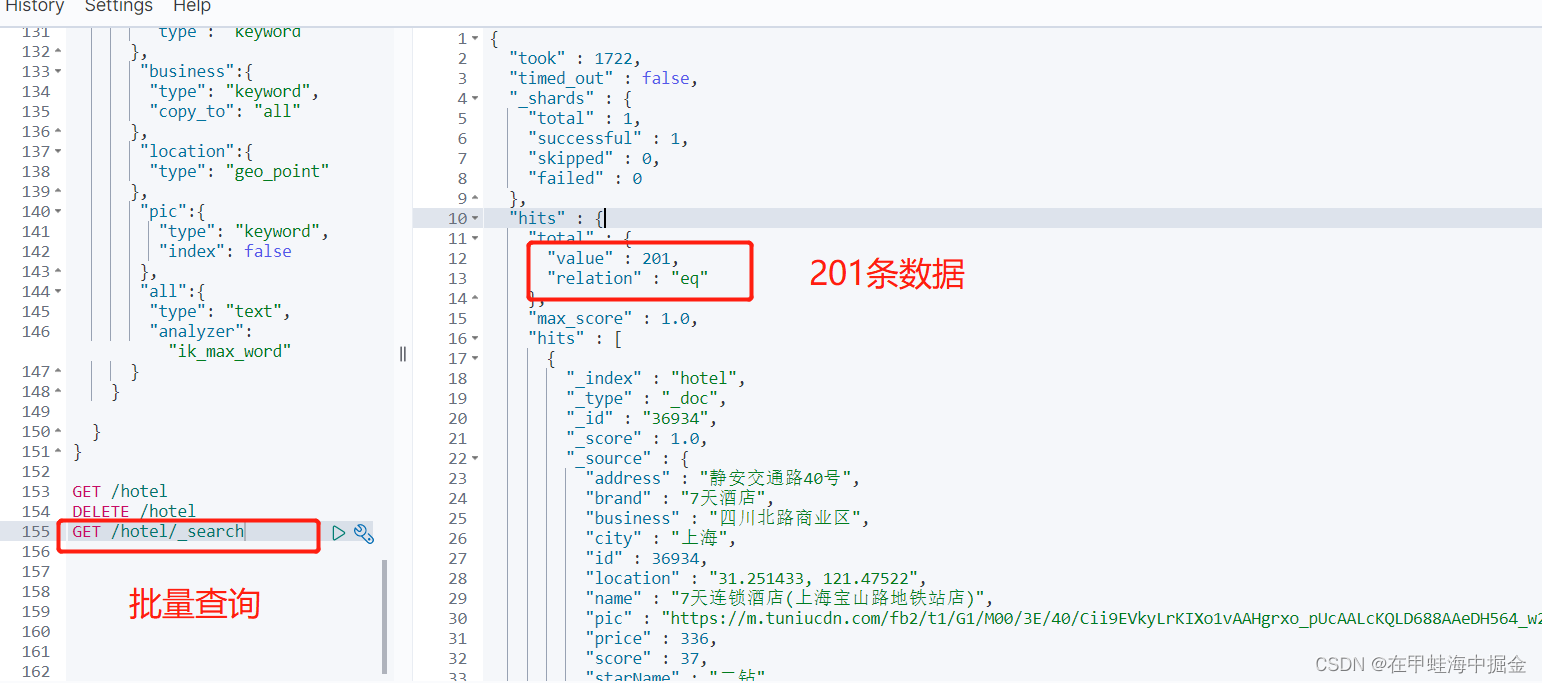继上一篇文章的对es的初步了解,接下来对其进行一些实战操作,来加深理解!
一、 索引库操作
1.1 mapping映射属性
mapping是对索引库中文档的约束,常见的mapping属性包括:
type:字段数据类型,常见的简单类型有:- ### 字符串:text(可分词的文本)、keyword(精确值,例如:品牌、国家、ip地址)- ### 数值:long、integer、short、byte、double、float、- ### 布尔:boolean- ### 日期:date- ### 对象:object
index:是否创建索引,默认为true
analyzer:使用哪种分词器
properties:该字段的子字段
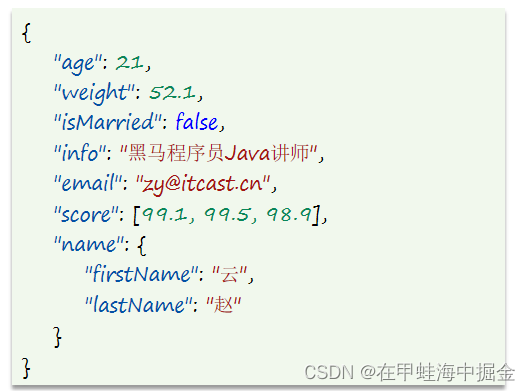
1.2 索引库的CRUD(增删改查)
1.2.1 创建索引库
ES中通过Restful请求操作索引库、文档。请求内容用DSL语句来表示。创建索引库和mapping的DSL语法如下:
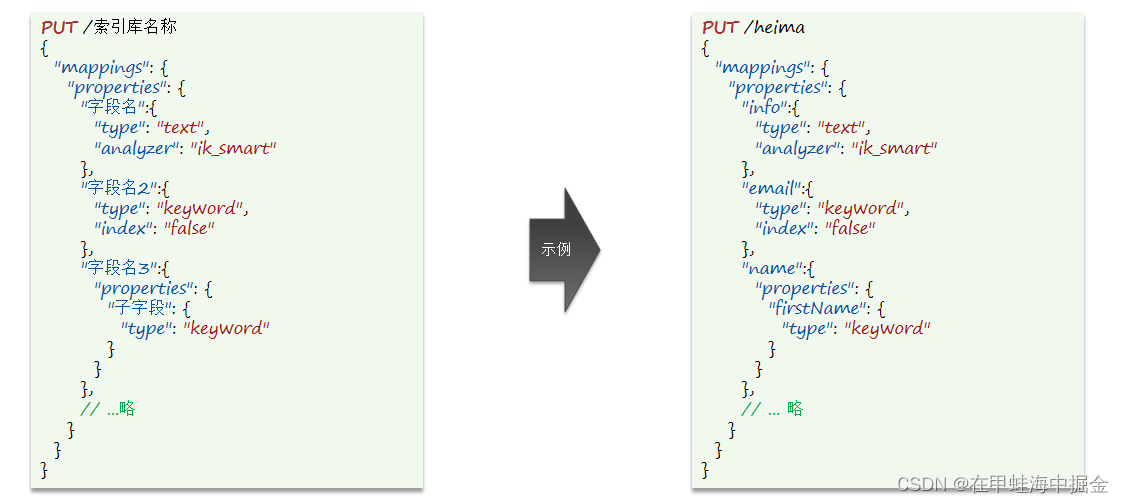
接下来就在kibana的可视化界面进行一下实战操作:
如果说这次的操作是在上一篇文章以后的话,虚拟机如果关闭了,可以将虚拟机打开了以后,输入以下命令:
syatemctl restart docker //打开docker
docker start es //打开es容器
docker start kibana //打开kibana可视化界面容器
docker ps //查看当前运行的容器
然后我们在浏览器输入http://本地ip:5601/ 进入可视化界面,然后在Dev Tools上进行后面的索引库和文档的CRUD操作:
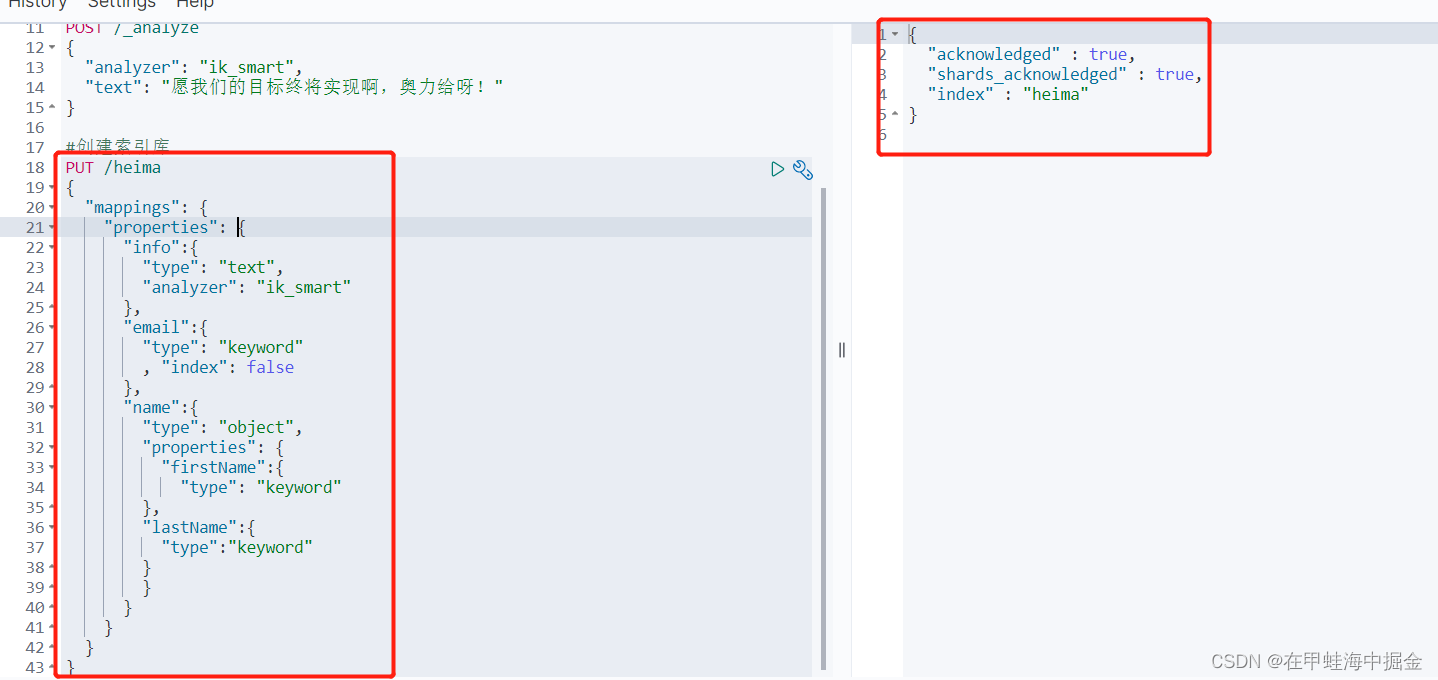
1.2.2 查看、删除索引库
查看索引库语法:
#GET /索引库名
# 示例
GET /heima
删除索引库语法:
# DELETE /索引库名
# 示例
DELETE /heima
1.2.3 修改索引库
索引库和mapping一旦创建无法修改,不允许对其进行修改,但是可以添加新的字段,语法如下:
!!*** 因为索引库创建完以后mapping映射都会映射好,而es会基于这些映射来创建倒排索引,如果说修改某一个字段,会导致倒排索引失效,所以禁止修改索引库,这与数据库不同,但是在生产阶段,数据库尽量也别修改,会直接影响性能。***
PUT /索引库名/_mapping
{
"properties": {
"新字段名":{ #切记字段名不能和之前原有的重复
"type": "integer"
}
}
}
二、文档操作
2.1 新增文档
新增文档的DSL语法如下:
POST /索引库名/_doc/文档id #文档id如果不写 会自动生成一个id
{
"字段1": "值1",
"字段2": "值2",
"字段3": {
"子属性1": "值3",
"子属性2": "值4"
},
// ...
}
# 示例
POST /heima/_doc/1
{
"info": "黑马程序员Java讲师",
"email": "[email protected]",
"name": {
"firstName": "云",
"lastName": "赵"
}
}
2.2 查询 删除文档
查询文档语法:
# GET /索引库名/_doc/文档id
# 示例
GET /heima/_doc/1
删除索引库的语法:
# DELETE /索引库名/_doc/文档id
# 示例
DELETE /heima/_doc/1
2.3 修改文档
方式一:全量修改,会删除旧文档,添加新文档
*** ****如果说id存在就是修改,如果说id不存在就是新增!!!!!*
PUT /索引库名/_doc/文档id
{
"字段1": "值1",
"字段2": "值2",
// ... 略
}
# 示例
PUT /heima/_doc/1
{
"info": "黑马程序员高级Java讲师",
"email": "[email protected]",
"name": {
"firstName": "云",
"lastName": "赵"
}
}
方式二:增量修改,修改指定字段值
POST /索引库名/_update/文档id
{
"doc": {
"字段名": "新的值",
}
}
# 示例
POST /heima/_update/1
{
"doc": {
"email": "[email protected]"
}
}
作为java程序员,需要将es用java代码实现出来,而不是简单地在可视化界面实现,下面就利用到RestClient来实现。
三、 RestClient操作索引库
ES官方提供了各种不同语言的客户端,用来操作ES。这些客户端的本质就是组装DSL语句,通过http请求发送给ES。官方文档地址:https://www.elastic.co/guide/en/elasticsearch/client/index.html
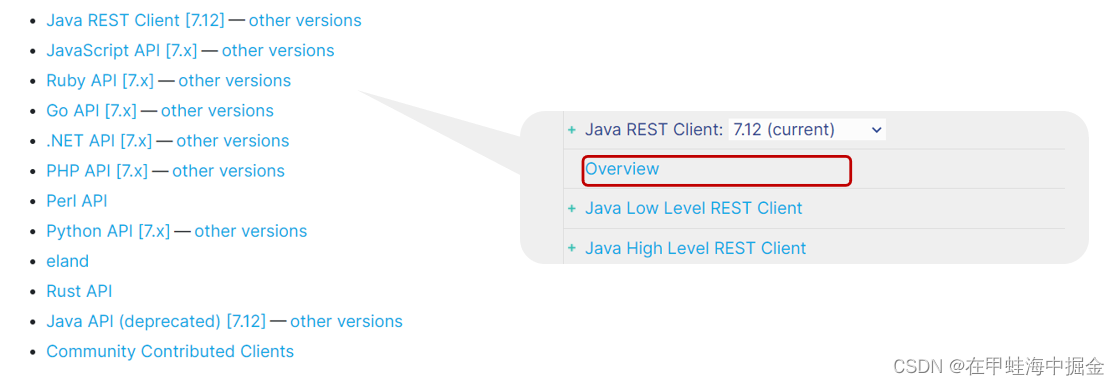
接下来通过一个案例来利用RestClient操作索引库
3.1 创建索引库
步骤一:首先导入上面所提供的数据库数据 tb_hotel.sql,然后导入所提供的项目hotel-demo
步骤二:然后可以对数据库的sql语句编写创建索引库,代码如下:
# 酒店的mapping
PUT /hotel
{
"mappings": {
"properties": {
"id":{
"type": "keyword"
},
"name":{
"type": "text",
"analyzer": "ik_max_word"
},
"address":{
"type": "keyword",
"index": false
},
"price":{
"type": "integer"
},
"score":{
"type": "integer"
},
"brand":{
"type": "keyword"
},
"city":{
"type": "keyword"
},
"starName":{
"type": "keyword"
},
"business":{
"type": "keyword"
},
"location":{
"type": "geo_point"
},
"pic":{
"type": "keyword",
"index": false
}
}
}
}
其中需要注意的是,sql中的经纬度字段,在es中有单独的表示类型:
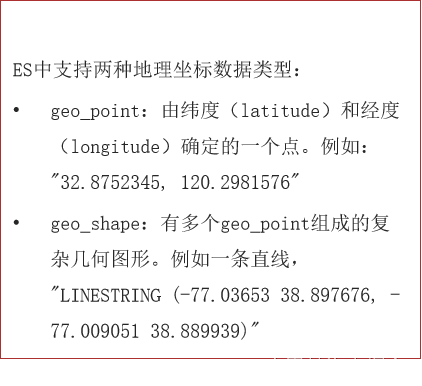
但是如果说用户想要对多个字段进行搜索比如说用过酒店名称搜、商圈搜等等,但是就数据库而言我们可以知道,只对一个字段就行搜索效率会很高,但是在es中如何做到既对多个字段搜索又能提高效率呢?
* 我们把想要参与搜索的字段统一放到“all”的索引中*
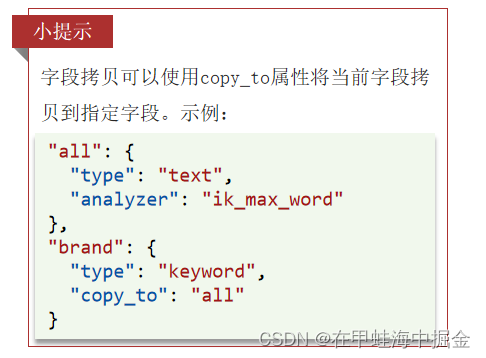
可以将上面的mapping映射代码修改为:
# 酒店的mapping
PUT /hotel
{
"mappings": {
"properties": {
"id":{
"type": "keyword"
},
"name":{
"type": "text",
"analyzer": "ik_max_word",
"copy_to": "all"
},
"address":{
"type": "keyword",
"index": false
},
"price":{
"type": "integer"
},
"score":{
"type": "integer"
},
"brand":{
"type": "keyword",
"copy_to": "all"
},
"city":{
"type": "keyword"
},
"starName":{
"type": "keyword"
},
"business":{
"type": "keyword",
"copy_to": "all"
},
"location":{
"type": "geo_point"
},
"pic":{
"type": "keyword",
"index": false
},
"all":{
"type": "text",
"analyzer": "ik_max_word"
}
}
}
}
步骤三 :初始化JavaRestClient
**1. 引入es的RestHighLevelClient依赖:**
<dependency>
<groupId>org.elasticsearch.client</groupId>
<artifactId>elasticsearch-rest-high-level-client</artifactId>
</dependency>
** 2. 因为SpringBoot默认的ES版本是7.6.2,所以我们需要覆盖默认的ES版本:**
<properties>
<java.version>1.8</java.version>
<elasticsearch.version>7.12.1</elasticsearch.version>
</properties>
** 3. 初始化RestHighLevelClient:**
可以新建一个测试类然后书写下面的代码:
package cn.itcast.hotel;
import org.apache.http.HttpHost;
import org.elasticsearch.client.RestClient;
import org.elasticsearch.client.RestHighLevelClient;
import org.junit.jupiter.api.AfterEach;
import org.junit.jupiter.api.BeforeEach;
import org.junit.jupiter.api.Test;
import java.io.IOException;
public class HotelIndexTest {
private RestHighLevelClient client;
@Test
void testInit(){
System.out.println(client);
}
@BeforeEach
void setUp(){
this.client=new RestHighLevelClient(RestClient.builder(
//这里改成自己的ip地址
HttpHost.create("http://192.168.229.101:9200")
));
}
@AfterEach
void tearDown() throws IOException {
this.client.close();
}
}
步骤四:创建索引库
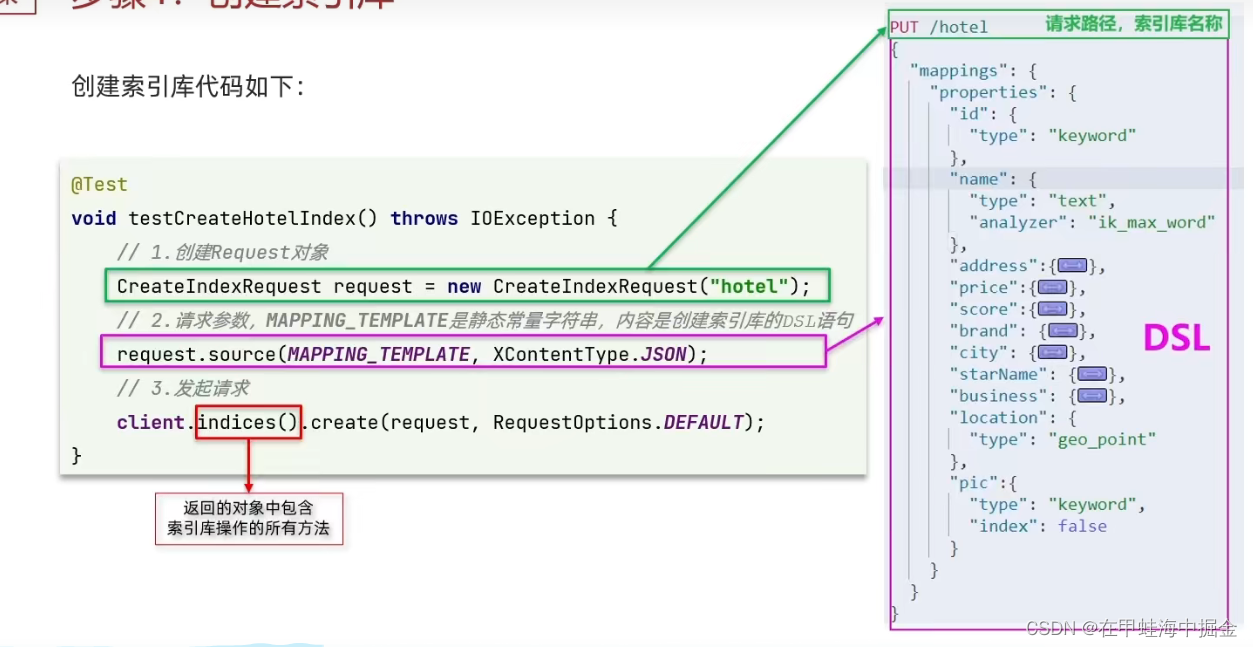
在测试类中新建一个测试方法 **createHotelIndex() **
@Test
void createHotelIndex() throws IOException {
//1. 创建Request 对象
CreateIndexRequest request = new CreateIndexRequest("hotel");
//2. 准备请求的参数:DSL语句
// 其中这个HotelSource是一个常量类,类里面就是之前所写的mapping映射代码,也可以直接复制到这个位置。
request.source(HotelSource, XContentType.JSON);
//3. 发送请求
client.indices().create(request, RequestOptions.DEFAULT);
}
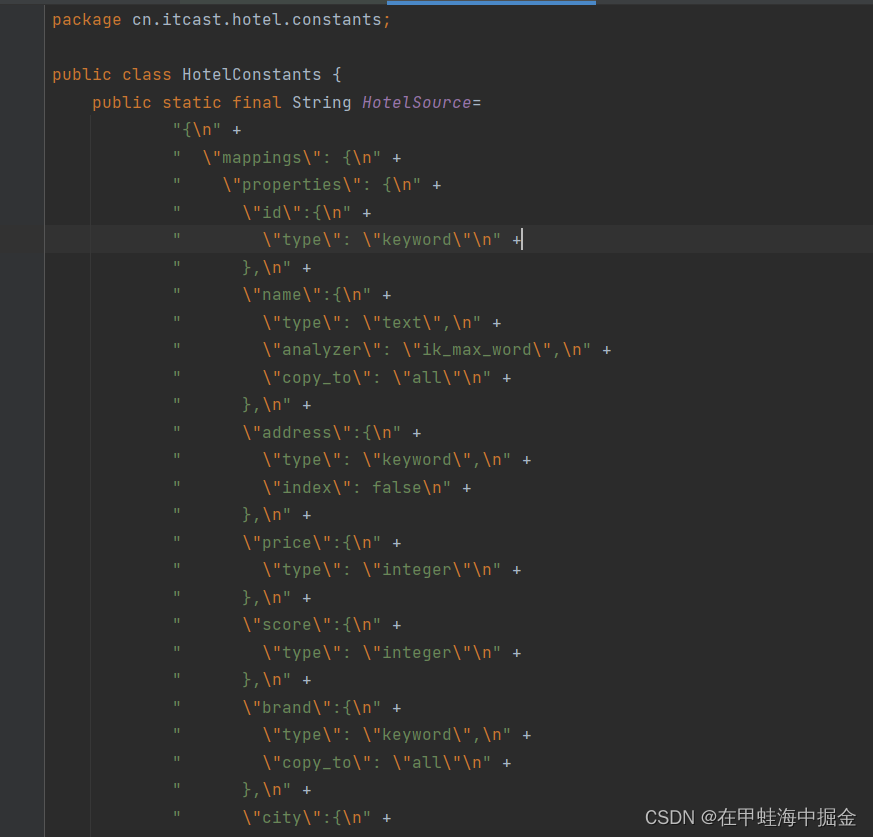
@Test
void createHotelIndex() throws IOException {
//1. 创建Request 对象
CreateIndexRequest request = new CreateIndexRequest("hotel");
//2. 准备请求的参数:DSL语句
request.source(HotelSource, XContentType.JSON);
//3. 发送请求
client.indices().create(request, RequestOptions.DEFAULT);
}
* 需要注意的是,导包一定要到对,不然会报错:*

最后在可视化界面中利用
GET /hotel
查看 如果有结果则说明创建索引库成功!!!
3.2 删除索引库
和创建索引库代码类似,只是调用方法不同。
@Test
void deleteHotelIndex() throws IOException {
//1. 创建Request 对象
DeleteIndexRequest deleteIndexRequest = new DeleteIndexRequest("hotel");
//2. 发送请求
client.indices().delete(deleteIndexRequest, RequestOptions.DEFAULT);
}
3.3 判断索引库是否存在
@Test
void existHotelIndex() throws IOException {
//1. 创建Request 对象
GetIndexRequest getIndexRequest = new GetIndexRequest("hotel");
//2. 发送请求
boolean exists=client.indices().exists(getIndexRequest, RequestOptions.DEFAULT);
//3. 输出是否存在
System.out.println(exists);
}
四、RestClient操作文档
案例:去数据库查询酒店数据,导入到hotel索引库,实现酒店数据的CRUD!
- 初始化JavaRestClient (和上面的对索引库操作的初始化代码一样,可以直接复制)
- 利用JavaRestClient新增酒店数据
- 利用JavaRestClient根据id查询酒店数据
- 利用JavaRestClient删除酒店数据
- 利用JavaRestClient修改酒店数据
4.1 新增文档

@Autowired
private IHotelService iHotelService;
@Test
void testAddDocument() throws IOException {
// 根据id查询酒店数据
Hotel hotel = iHotelService.getById(61083L);
// 转换为文档类型
HotelDoc hotelDoc = new HotelDoc(hotel);
//1. 准备 Request对象
IndexRequest request = new IndexRequest("hotel").id(hotel.getId().toString());
//2. 准备Json文档
request.source(JSON.toJSONString(hotelDoc),XContentType.JSON);
//3. 发送请求
client.index(request,RequestOptions.DEFAULT);
}
当查询出id=61083的数据以后则说明新增文档成功!!!
4.2 查询文档
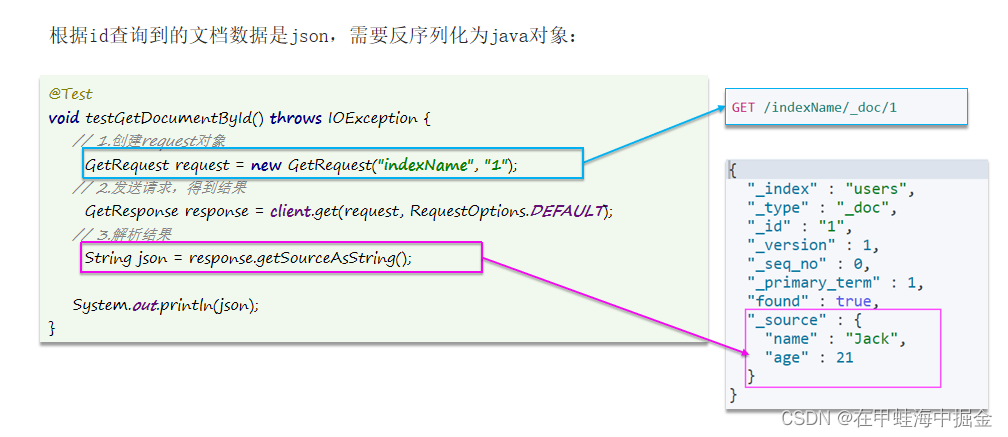
@Test
void testGetDocumentById() throws IOException {
//1. 准备Request
GetRequest request = new GetRequest("hotel","61083");
//2. 发送请求,得到相应
GetResponse response = client.get(request, RequestOptions.DEFAULT);
//3. 解析响应结果
String source = response.getSourceAsString();//反序列化 将json对象转化成java对象
System.out.println(source);
}
得到结果如下,说明查询成功:

4.3 删除文档
@Test
void testDeleteDocumentById() throws IOException {
//1. 准备request
DeleteRequest request = new DeleteRequest("hotel","61083");
//发送请求
client.delete(request,RequestOptions.DEFAULT);
}
当出现下面的信息时,说明id=61083的酒店信息删除成功!!
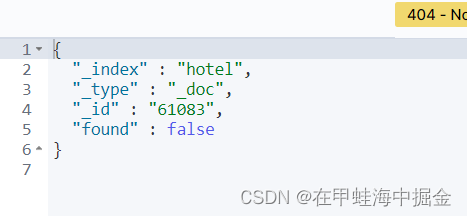
4.4 修改文档
修改文档数据有两种方式:
方式一:全量更新。再次写入id一样的文档,就会删除旧文档,添加新文档(和新增没啥区别)
方式二:局部更新。只更新部分字段,我们演示方式二

@Test
void testUpdateDocumentById() throws IOException{
//1. 创建request对象
UpdateRequest request = new UpdateRequest("hotel","61083");
//2. 准备参数,每2个参数为一对key value
request.doc(
"price","999",
"starName","四钻"
);
//3. 更新文档
client.update(request,RequestOptions.DEFAULT);
}

4.5 批量导入文档
需求:批量查询酒店数据,然后批量导入索引库中
思路:
利用mybatis-plus查询酒店数据
将查询到的酒店数据(Hotel)转换为文档类型数据(HotelDoc)
利用JavaRestClient中的Bulk批处理,实现批量新增文档,示例代码如下:
//批处理
@Test
void testBulkRequest() throws IOException {
//1. 创建Request
BulkRequest request = new BulkRequest();
// 批量查询酒店数据
List<Hotel> hotels = iHotelService.list();
//转换为文档类型的HotelDoc
for(Hotel hotel:hotels) {
HotelDoc hotelDoc = new HotelDoc(hotel);
//创建新增文档的Request对象
//2. 准备参数,添加多个新增的Request
request.add(new IndexRequest("hotel")
.id(hotelDoc.getId().toString())
.source(JSON.toJSONString(hotelDoc),XContentType.JSON));
}
//3. 发送请求
client.bulk(request,RequestOptions.DEFAULT);
}
以上就是对es的简单实践,包括对索引库以及文档的CRUD、最后实现了数据的批处理。内容若有不足,希望大家批评指正,我们一起努力!
版权归原作者 在甲蛙海中掘金 所有, 如有侵权,请联系我们删除。
